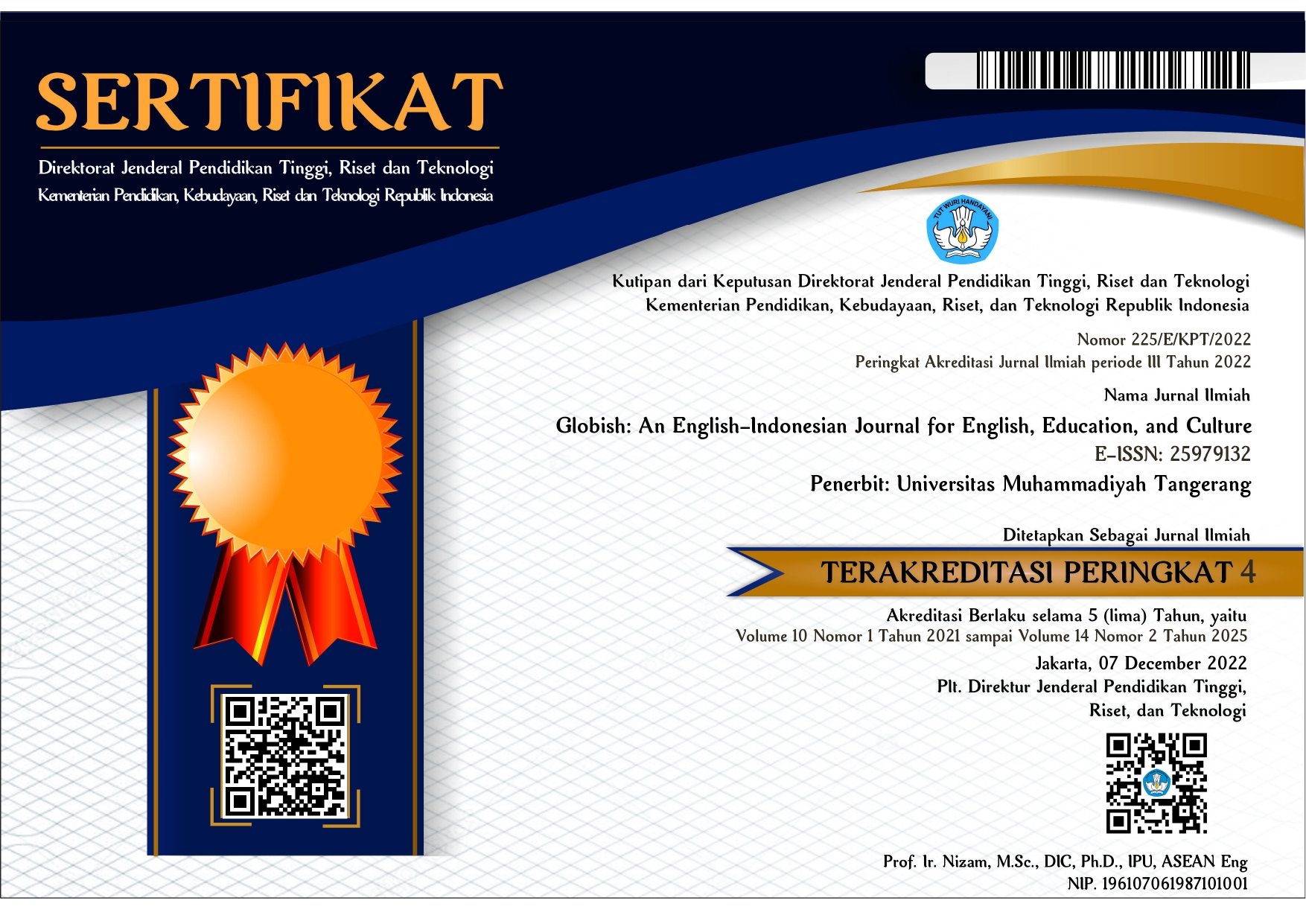Unravelling Gender Inequality: A Semiotic Analysis of Taylor Swift's Song Lyrics
Abstract
This study aims to explore the semiotic representations of gender inequality within Taylor Swift's song lyrics. Utilizing a descriptive qualitative method, it analyzes the signifier and signified embedded in her music. Drawing upon Ferdinand de Saussure's semiotic theory, the study delves into the material aspects of language—what is seen, heard, or read (signifier)—and the corresponding mental images or concepts (signified). Through a comprehensive analysis of Swift's songs, including "The Man," "Mad Woman," and "Look What You Made Me Do," the research uncovers the pervasive gender gap and mistreatment faced by women in various societal contexts. Data collection involves listening to the songs, understanding their meaning, and observing instances of discrimination against women in daily life. The findings highlight the significance of Swift's music as a platform for discourse on gender inequality, shedding light on the ongoing struggle for women's rights in contemporary society.
Keywords
Full Text:
PDFReferences
Arum, F. (2021). Pengertian Semiotika: Konsep Dasar, Macam, dan Tokoh Pencetusnya. Gramedia Pustaka Utama.
Caroline, Y. P., Zahrani, T., Sitompul, M. R., & Rangkuti, R. (2023). A Feminist-Stylistic Analysis of the Taylor Swift Song Entitled The Man. KLAUSA (Kajian Linguistik, Pembelajaran Bahasa, Dan Sastra), 7(2), 115–124. https://doi.org/10.33479/KLAUSA.V7I2.881
Chandler, D. (2017). Semiotics: The Basic (Third). Routledge, Taylor & Francis Group.
Desmarais, J. (2021). Late-Victorian Decadent Song Literature. Victorian Literature and Culture, 49(4), 689–710. https://doi.org/10.1017/S1060150320000224
Fauzi, R. H., & Hakim, L. (2022). Tertiary Esl Students’ Perceptions on the Acquired and Used Languages ( A Case Study at University Level). Globish: An English-Indonesian Journal for English, Education, and Culture, 11(2), 139–151. https://doi.org/10.31000/GLOBISH.V11I2.6575
Firdaus, E. A. (2013). Textual Meaning in Song Lyrics. Passage, 1(1), 99–106. https://doi.org/10.17509/PSG.V1I1.349
Gerring, J. (2017). Qualitative Methods. https://doi.org/10.1146/annurev-polisci-092415
Goziyah, G., Yusuf, M., & Hanim, I. (2022). Contextual Analysis n Public Service Advertisements from the Ministry of Education and Culture: Overseas Worker. Globish: An English-Indonesian Journal for English, Education, and Culture, 11(1), 20–29. https://doi.org/10.31000/GLOBISH.V11I1.5331
Indra, Y., Syahan, R. S., Triana, A., Dalpah, D., & Ardelia, S. (2024). Discovering Culture and English: My Learning Experience at Ahmad Dahlan University through UMT’s Study Abroad Program. Globish: An English-Indonesian Journal for English, Education, and Culture, 13(1), 115–124. https://doi.org/10.31000/GLOBISH.V13I1.10485
Khurshid, R., & Farid, A. (2023). Power And Identity In Taylor Swift’s Song, “Look What You Made Me Do”: A Deconstructive Analysis. Global Language Review, VIII(I). 24(I), 258–266. https://doi.org/10.31703/glr.2023(VIII-I).24
Krause, A., & North, A. (2019). Pop Music Lyrics are Related to the Proportion of Female Recording Artists: Analysis of the United Kingdom Weekly Top Five Song Lyrics, 1960–2015. Psychology of Popular Media Culture, 8(3), 233–242. https://doi.org/https://doi.org/10.1037/ppm0000174
Logan, B., Kositsky, A., & Moreno, P. (2004). Semantic Analysis of Song Lyrics. 2004 IEEE International Conference on Multimedia and Expo (ICME), 827–830. https://doi.org/https://doi.org/10.1109/ICME.2004.1394328
Macis, M. (2017). Gender differences in wages and leadership. The IZA World of Labor. https://doi.org/10.15185/IZAWOL.323
Mahmud, H., Ma’arif, A., Sidik, ;, Ajeng, J. ;, & Marlinda, P. (2022). Music as Propaganda for Humanitarian Diplomacy: Semiotic Analysis of Ferdinand de Saussure in The Song We Are The World. International Journal of Multicultural and Multireligious Understanding, 9(9), 144–157. https://doi.org/10.18415/IJMMU.V9I9.3944
Miles, M. B., Huberman, A. M., & Saldana, J. (2014). Qualitative data analysis: A methods sourcebook. Sage Publications, Inc.
Putri, C., Duwila, S., & Sabriana, M. (2022). Representation of Feminism in Taylor Swift’s Songs. Prosiding Seminar Nasional & Call for Paper “Peran Perempuan Sebagai Pahlawan Di Era Pandemi” PSGESI LPPM UWP, 9(01), 233–240. https://doi.org/10.38156/GESI.V9I01.143
Rokhimah, S. (2015). Patriarkhisme Dan Ketidakadilan Gender. Muwazah, 6(1). https://doi.org/10.28918/MUWAZAH.V6I1.440
Setiawati, W., & Maryani, M. (2018). An Analysis of Figurative Language in Taylor Swift’s song lyrics. Project (Professional Journal of English Education), 1(3), 261. https://doi.org/https://doi.org/10.22460/project.v1i3.p261-268
Sovič, A., & Hus, V. (2016). Semiotic Analysis of the Textbooks for Young Learners. Creative Education, 07(04), 639–645. https://doi.org/10.4236/CE.2016.74066
Swari, R. (2023). Women Underrepresentation in the MusicIindustry Reflected from Taylor Swift’s Billboard “Woman of the Decade” Speech. Kulturistik Jurnal Bahasa Dan Budaya, 7(2), 1–6. https://doi.org/https://doi.org/10.22225/kulturistik.7.2.7453
Yakin, H. S. M., & Totu, A. (2014). The Semiotic Perspectives of Peirce and Saussure: A Brief Comparative Study. Procedia - Social and Behavioral Sciences, 155, 4–8. https://doi.org/10.1016/J.SBSPRO.2014.10.247
DOI: http://dx.doi.org/10.31000/globish.v13i2.11305
Article Metrics
Abstract - 2939 PDF - 4664Refbacks
- There are currently no refbacks.
Globish
Program Studi Pendidikan Bahasa Inggris
Fakultas Keguruan dan Ilmu Pendidikan
Universitas Muhammadiyah Tangerang
Jl. Perintis Kemerdekaan I/33, Cikokol
Kota Tangerang, Indonesia
e-mail: globish_journal@umt.ac.id
Globish (p-ISSN: 2301-9913 | e-ISSN: 2301-9913) is licensed under a Creative Commons Attribution-ShareAlike 4.0 International License.









